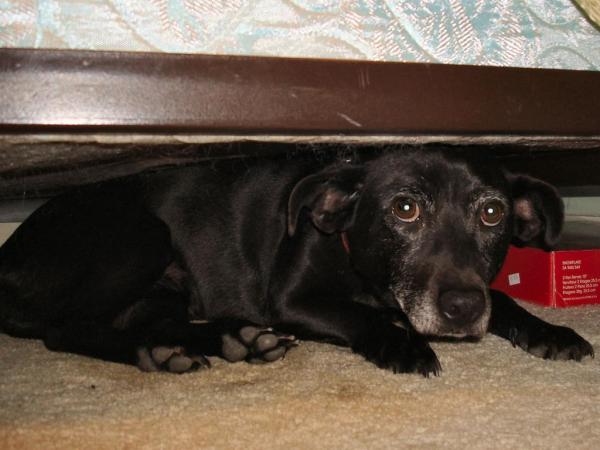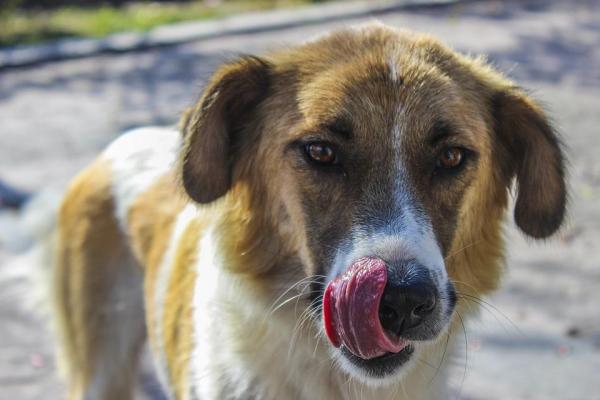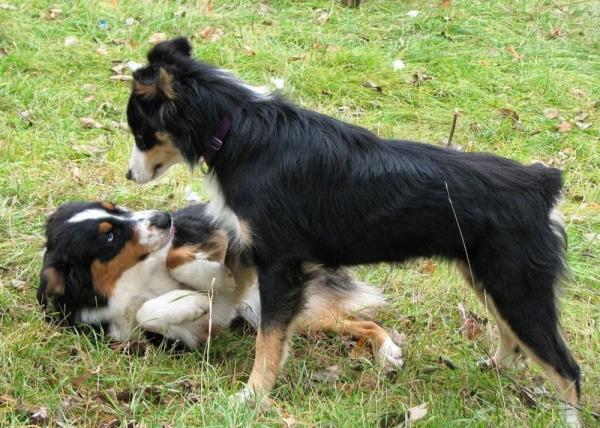
Although domestication has led to companion dogs having a greater sense of security than their wild counterparts, it is important their retain the ability to be scared. When a dangerous or threatening situation arises, dogs use their natural instincts to protect themselves on both physiological and psychological levels. Unfortunately, certain issues can lead to dogs developing fear when it is unhelpful, something which can lead to phobias. It can change their behavioral and even threaten their overall health.
At AnimalWised, we look at the top 10 signs a dog is scared of something. By recognizing these symptoms of fear and phobias in dogs, we can better assess their situation and provide better care for them.
Why are dogs afraid?
Fear is an adaptive emotion that appears when a dog perceives an imminent danger. It is essential to differentiate fear from anxiety. Anxiety is a chronic state of insecurity which can develop from phobias and occur in situations which don't actually provide any imminent danger. When a dog is very scared, they can become paralyzed, try to flee the situation or even become aggressive.
Causes of fear in dogs
Fear commonly derives from a poor socialization period. This is a period during which the dog is introduced to various stimuli and situations which they are likely to encounter in their later lives. By learning how to respond during the dog's socialization phase, they will have the ability to respond appropriately later in life. If this period is neglected or their experience negative situations during this time, it will likely set the groundwork for phobias.
Trauma before, during or after socialization of dogs can also lead to fear in later life. This can be due to accidental trauma, physical abuse, emotional abuse, abandonment or other causes. They may associate this fear with very particular situations or it may be generally pervasive. There are also genetic influences which can cause dogs to be overly fearful[1].
Pathological illnesses can threaten the security of the dog to the point they are persistently scared. They may be experiencing health problems we cannot otherwise perceive, with fear being the manifestation we eventually recognize. If the fear is allowed to become chronic, it will threaten their health. Some studies even show that dogs with chronic fear and anxiety will have a shorter life expectancy[2].
No we know some of the causes of fear in dogs, we need to know how it manifests in their behavior. We do this in the sections below by looking at some of the main symptoms and signs your dog is scared.

1. Tail down or between the legs
As humans, we may associate the concept of having your tail between your legs as a metaphor for being embarrassed or even ashamed. Dogs do not feel embarrassment, but they do feel fear. If we see a dog with their tail down or between their legs, it is likely they are scared. Excessive or exaggerated movements can also signal phobias.

2. Ears backwards or close to the head
Ears pulled back or glued to the head are also easy signs of fear in dogs to recognize. This is an important sign to monitor in dogs. When they are sufficiently scared, putting the ears close to the head is also a calming signal in dogs which may suggest their are about to be aggressive.

3. Crouched body or stooped posture
A frightened dog will show a hunched body and may also walk in a crouched manner. This posture tells us our canine is feeling insecure, not something they should feel in a calm and positive environment.

4. Hide somewhere sheltered
When a dog feels scared, they often want to find somewhere they can feel secure. A hiding place is a small environment over which they can have control and protect themselves from outside forces. This can happen regularly when a dog has prolonged anxiety, but it can also happen in acute episodes of fear. An example of the latter might be when there are loud fireworks outside.
Learn more with our article on why my dog is hiding and acting strange.

5. Try to escape
In a situation in which they perceive imminent danger, it is logical for a dog to want to escape. Running away to safety is a basic method of dealing with insecurity and is healthy when there is actual danger. When there isn't, such a need to flee with foster high levels of anxiety and stress in dogs.
6. Calming signals
Frightened dogs may also display different calming signals, such as licking their lips, yawning continuously, turning their heads, squinting, shrinking, averting their gaze or glancing sideways. This is in addition to many other common body language cues, some of which we have already mentioned.

7. Submissive postures
Submission in dogs is an adaptive response that has allowed them to establish a hierarchy and survive in packs. It is important to highlight that within the same group of dogs that live together, variable hierarchies can be generated. They do not always follow a linear pattern. Submissive postures appear regularly in intraspecies relationships, i.e. between individuals of the same species. It does not occur between dogs and humans or other animal species.
A dog adopts such postures voluntarily when they recognize a dominant individual, expressing submission to the will of the dominant dog. However, on some extreme occasions, a dog can also carry out submission postures when recognizing itself in a situation of high stress and fear. In these cases, these postures are usually accompanied by calming signals and the other symptoms of fear mentioned in this list.

8. Muscle stiffness and tremors
Situations of high stress or that cause intense fear in dogs can lead to physiological changes. Muscle stiffness and shaking are some of the most common. A frightened dog shows tense muscles and may even tremble in fear. In more extreme situations, the dog may also be so scared they become immobilized.
9. Involuntary urination
Fear urination is different from submissive urination. A dog that urinates out of intense fear does so involuntarily when faced with a situation they cannot endure. For example, if your dog urinates when you scold them, it is a very obvious symptom this situation causes such fear to the point they lose control of their urinary tract.
In more severe cases, the dog may also defecate and empty their anal glands in a context of heightened stress and fear. For this reason, it is essential to eliminate physical punishment. Use positive reinforcement to properly educate your dog and stimulate their cognitive, emotional and social abilities.

10. Stereotypies
In cases of chronic fear and anxiety, dogs can develop stereotypies. These are behaviors which the dog repeats incessantly, but which serve no helpful purpose to them. They often occur when the dog has prolonged exposure to stressful and negative environments where fear is consistently promoted.
The most commonly observed stereotypies in dogs are chasing and nipping their tail, excessive biting or licking of their fur, incessant barking and chasing imaginary flies, among others. Some behaviors may be particularly odd, such as licking metal or licking urine off the ground.

Fear aggression in dogs
Fear can also cause dogs to carry out aggressive behavior, known as defensive aggressiveness. When the dog finds themselves in a situation where their physical integrity is threatened, aggressiveness can be used as a defense mechanism. It is designed to preserve well-being against the dangers of its environment. Although there is no real danger to them, their perception of it is sufficient to trigger aggression.
Aggressiveness due to fear in dogs can be identified through some bodily and behavioral signs, such as:
- Bearing teeth
- Bristling hair
- Muscule stiffness
- Loud, rapid and constant barking
- Snarling
- Panting excessively
- Crying and/or whining
Aggression in dogs is a serious behavioral problem that needs to be treated quickly and properly to preserve the well-being of the dog and everyone around them. A dog with aggressiveness due to fear can react in an excessive way. In extreme cases, it can lead to attacks on humans which result in the dog being euthanized.
In these cases we speak of redirected aggressiveness. This occurs when the dog is incapable of attacking the stimulus that causes fear and ends up biting anything around them, such as his guardian or caregiver. This behavior does not appear because of malice or cruelty. There is no mean or cruel animal by nature. It occurs because intense fear overcomes them and they are no longer able to maintain balanced and self-confident behavior.
If you notice that your dog is very fearful, scared easily and/or presents any of the symptoms mentioned in this article, don't hesitate to take them to the vet. Fear can be due to both physiological and psychological issues, so they can examine for the former and assess for the latter.
After ruling out any pathological cause, we recommend you seek the guidance of a canine ethologist to verify the causes of your dog's fear and behavioral problems. They can establish some specific guidelines for treatment according to their individual needs.
If you want to read similar articles to Signs a Dog Is Scared of Something, we recommend you visit our Behavioral problems category.
1. Dias, B. G, & Ressler, K. J. (2014). Parental olfactory experience influences behavior and neural structure in subsequent generations. Nature Neuroscience, 17(1), 89-96.
2. .Dreschel, N. A. (2010). The effects of fear and anxiety on health and lifespan in pet dogs. Applied Animal Behavior Science, 125(3–4), 157-162.